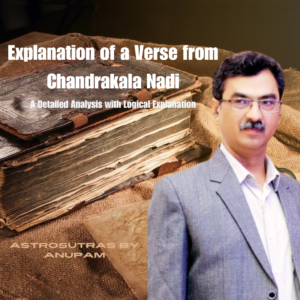Aspects in Tajika Shastra: A Detailed Explanation
Tajika Shastra is a unique branch of Vedic astrology primarily used for annual (Varshaphala) charts and Prashna (Horary astrology). Unlike the Parashari system, which uses full and partial aspects of planets, Tajika astrology follows a distinct system of planetary aspects derived from Persian and Hellenistic influences.
This system focuses on Tajika aspects, which are fundamentally different from Parashari aspects and operate with orb-based influence and planetary relationships.
1. What are Tajika Aspects?
In Tajika Shastra, aspects are called “Tajika Drishti” (ताजिक दृष्टि), and they function based on angular distance between planets rather than sign-based rules. The key aspects are derived from harmonic divisions of the 360° zodiac and represent geometrical angles between planets.
The major aspects used in Tajika Shastra are:
| Aspect Name | Angle | Nature |
|---|---|---|
| Ithasala (Applying Aspect) | Any | Favorable |
| Isarapha (Separating Aspect) | Any | Weak Influence |
| Sextile (Shashtashtaka Yoga) | 60° | Benefic |
| Square (Kendra/Chaturasra Yoga) | 90° | Malefic |
| Trine (Trikona Yoga) | 120° | Strong Benefic |
| Opposition (Samapatha Yoga) | 180° | Malefic |
| Conjunction (Sannikarsha) | 0° | Neutral (Depends on Planets) |
Each of these aspects has specific rules and interpretations, and they are used to judge planetary strength and influence in annual charts.
2. Types of Tajika Aspects and Their Effects
(A) Ithasala Yoga (Applying Aspect) – The Most Powerful Aspect
- Definition: When a faster-moving planet is approaching a slower-moving planet within its orb of influence, it forms an Ithasala Yoga.
- Significance: This is a highly beneficial aspect indicating success, fulfillment of desires, and smooth results.
- Orb of Influence: Planets should be within 7-8 degrees of each other for this aspect to work.
Example:
If Moon (fast planet) at 12° Taurus is moving towards Venus at 18° Taurus, an Ithasala aspect is formed → Indicates successful outcome in Varshaphala predictions.
No Ithasala if the slower planet is moving away from the faster planet.
(B) Isarapha Yoga (Separating Aspect) – Weak Influence
- Definition: If a faster planet is moving away from a slower planet, the aspect is called Isarapha Yoga.
- Significance: Weak or delayed results → Efforts may not be successful, or results will take longer.
- Orb of Influence: Same as Ithasala (within 7-8 degrees).
Example:
If Moon at 18° Taurus is moving away from Venus at 12° Taurus, this is an Isarapha aspect, meaning the desired event is unlikely to happen quickly.
(C) Samagama (Conjunction) – Neutral or Mixed Results
- Definition: When two planets are at the same degree, they are in Samagama (conjunction).
- Significance:
- If benefics (Jupiter & Venus) conjoin → Positive results.
- If malefics (Saturn & Mars) conjoin → Hurdles and obstacles.
- If a benefic and malefic conjoin → Mixed results.
Example:
If Sun and Mercury are conjunct in a Varshaphala chart → Intelligence and success in communication.
If Saturn and Mars are conjunct → Conflicts and difficulties.
(D) Shashtashtaka Yoga (Sextile – 60°) – Benefic
- Definition: When two planets are 60° apart, they form a Sextile.
- Significance: This is a soft, supportive aspect that brings opportunities, cooperation, and positive outcomes.
Example:
If Jupiter at 10° Aries aspects Venus at 10° Gemini, this Sextile aspect promotes harmony, wealth, and creativity.
(E) Chaturasra Yoga (Square – 90°) – Malefic
- Definition: When two planets are 90° apart, they form a Square.
- Significance: This is a challenging aspect, bringing conflict, delays, and struggles.
Example:
If Mars at 10° Aries aspects Saturn at 10° Cancer, this Square aspect causes frustration, obstacles, and tension.
(F) Trikona Yoga (Trine – 120°) – Strong Benefic
- Definition: When two planets are 120° apart, they form a Trine.
- Significance: This is the most beneficial aspect, giving success, wealth, and smooth progress.
Example:
If Jupiter at 10° Aries aspects Sun at 10° Leo, this Trine aspect ensures growth, prosperity, and authority.
(G) Samapatha Yoga (Opposition – 180°) – Malefic
- Definition: When two planets are 180° apart, they form an Opposition.
- Significance: This is a difficult aspect, bringing conflicts, struggles, and duality.
Example:
If Moon at 15° Taurus opposes Saturn at 15° Scorpio, this Opposition aspect creates emotional stress, delays, and challenges.
3. Special Considerations in Tajika Aspects
- Ithasala and Isarapha are used for prediction in Varshaphala (Annual Horoscope).
- Ithasala (Applying Aspect) guarantees success, whereas Isarapha (Separating Aspect) weakens results.
- Malefic aspects (Square & Opposition) bring struggles, while Benefic aspects (Trine & Sextile) bring ease.
- Tajika aspects are angle-based, unlike Parashari aspects which are sign-based.
- Combustion weakens aspects → If a planet is combust by the Sun, its aspect becomes weaker.
- Tajika system uses orbs (5°-8° for most aspects).
4. Practical Uses of Tajika Aspects
1. Varshaphala Predictions
- If Ithasala is present between Lagna Lord and 10th Lord, the native will have career success that year.
- If Isarapha is present, career progress may slow down or face obstacles.
2. Prashna (Horary Astrology)
- If Ithasala exists between 7th Lord and 1st Lord, marriage or partnership will happen soon.
- If Isarapha exists, the marriage may be delayed or fail.
3. Financial Success
- A Trine or Sextile aspect between 2nd and 11th lords → Profits and wealth.
- A Square or Opposition between 2nd and 11th lords → Financial problems.
Conclusion
Tajika Aspects provide a precise and predictive approach in annual horoscopes (Varshaphala) and Prashna charts. Unlike Parashari aspects, which are sign-based, Tajika aspects focus on angular degrees, making them more dynamic and applicable to yearly events.

